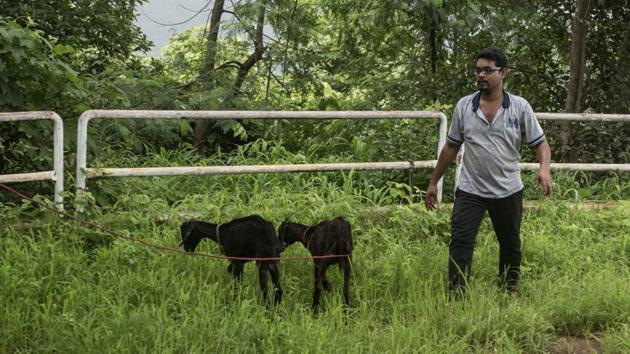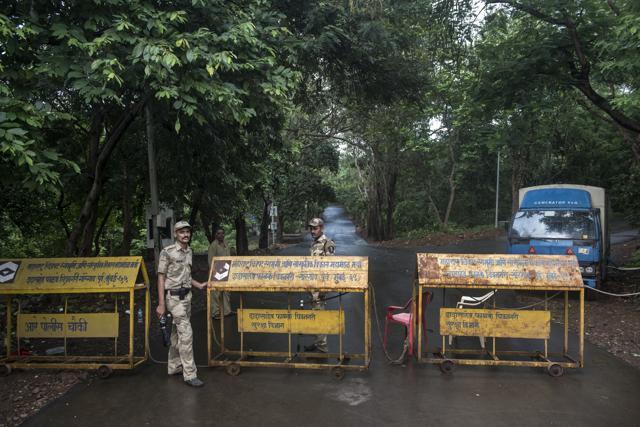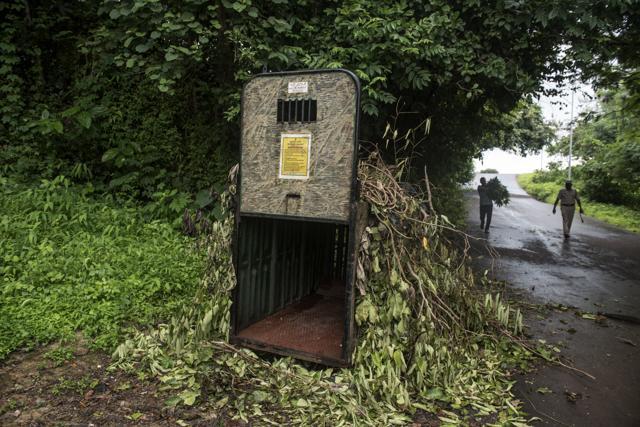At Mumbai’s Aarey Colony, officials continue long wait to trap leopard that attacked five
The attacks, which started in March, have spread panic among residents of this wooded area south of Mumbai’s Sanjay Gandhi National Park
Armed with a megaphone, electric torches, mosquito repellent and water bottles, four forest officers are on patrol at Mumbai’s Aarey Milk Colony, waiting for the leopard suspected to have attacked five people and killed one. Officials plan to entice the big cat with a live goat, then trap it in a cage. They started their vigil last Saturday.

The attacks, which started in March, have spread panic among residents of this wooded area south of Sanjay Gandhi National Park, which has around 35 free-roaming leopards. A 5-km stretch has been cordoned off, with restrictions on outdoor shoots in the nearby Dadasaheb Phalke Chitranagari area — Film City.

Tribals and slum-dwellers living near Aarey have been asked to watch out for leopards after dark. As many as 15 forest officers have been working in three shifts, waiting near two trap cages installed 2.5km from each other, along a hilly path between the gate at Bapu Gram Naka and the Aarey helipad. Each have a goat tied inside. They are being fed regularly.
“This zone will remain sealed till August 7. We are aware of the big cat’s movements and know it won’t attack adults. However, children are vulnerable as they are at the leopard’s eye level,” said Pradeep Mali from the Thane forest range and a member of the team.
After examining trap images and comparing them to the leopard’s spots, forest officials realised it was a single cat behind the attacks. The animal has probably inspected the traps, however, it refuses to take the bait. “Our reports suggest that the leopard has visited the spot, moved around the cage, but did not attack the goat. We will continue patrolling the area till the animal is trapped,” said Santosh Kank, range forest officer, Mumbai.

“The idea is to let the leopard become familiar with the trap cage. We will wait since it is humans who have entered their habitat,” said said Mangesh Bakkar, an officer with Thane forest range.
The leopard has been active around the area’s eight tribal settlements, each of which houses close to 200 people. The forest officials have given the villagers and Film City staff instructions on how to avoid an encounter with a leopard.
“We set out daily, in groups of four, to the cordoned-off areas where attacks have taken place. Using a megaphone, we inform the tribals to ensure that their children are not outside during the evening,” said Santosh Bhagne, an officer who led the rescue team.
So far there has been no sign of the animal. There have neither been camera images nor pug marks in the wet soil. However, forest department officials said cages were the best way to trap the cat, no matter how long it may take. There are 15 camera traps installed across the area, but the forest guards do not have dart guns or sticks to protect themselves. “Only trained officers from Sanjay Gandhi National Park have been given dart guns, ” said Mali.
Senior forest officials said the guards were not handicapped by the lack of advanced equipment. “We are always open to suggestions and can provide them with bamboo sticks. But, we have given them the freedom to come up with their own strategy for trapping the animal as they have been trained to tackle such situations,” said Jitendra Ramgaokar, deputy conservator of forest, Thane.

While trap cages are basic, long-established means of trapping leopards according to the Union environment ministry’s guidelines, using darts with anesthesia is common in Uttarakhand, Himachal Pradesh and Karnataka. said wildlife experts.
“There is a need to monitor the leopard’s activity for a week to 10 days. Only then will the forest guards understand how it moves. They can then think about using other techniques,” said Tito Joseph, programme coordinator, Wildlife Protection Society of India.
In the US, UK and Sweden, foot loop traps are used to trap killer leopards. They are adjusted such that they do not hurt the animal. The snare clamps the animal’s foot, after which foresters use darts to anaesthetise it. “Snares or foot loop traps are completely banned in protected forest areas to avoid poaching,” said Joseph. “However, in forests near cities, it can be considered only if the animal is a man-eater,” he said.
How are animals trapped around the world?
CAGE TRAPPING
Advantages:
• They are easy to set up and can be placed at the exact location of the attack
• Animals can be trapped and released without having to be anaesthetised
• Large chunks of meat can be used as bait
Disadvantages:
• Cages are big, intrusive structures. Leopards can be wary of this, especially if they are hunted
• It takes a lot of manpower to set up each cage. Thus, they can only be set up next to roads and are not easily moved
• They are expensive
• They are ineffective and take long to trap an animal
FREE DARTING
Problematic animals can be darted on foot or from a vehicle
Advantages:
• Can control an aggressive animal, without killing it
Disadvantages:
• Selective, only leopards can be darted
• They can hurt the animal. A darted cat may fall off a tree. This can be avoided by using drugs to calm a leopard who is feeding.
• The capture team may be in danger if a darted animal run offs, particularly if the tranquilliser has only partially been injected.
• The darted leopard may be vulnerable to attacks from other animals.
• It is not easy to dart a leopard during night
• It is time-consuming as darting can only start when the leopard starts to feed on bait.
FOOT-LOOP TRAPS/SOFT CATCH TRAPS
Not to be confused with conventional crude wire snares set illegally to catch bush meat, it is a modified snare used to trap large carnivores for several decades. In Africa, large carnivore researchers have switched from using cage traps to foot loop traps over the past decade. These are leg-hold traps that clamp the animal’s legs while it is feeding. It can then be darted by foresters. It is however, not used in India at all.
Advantages:
• They are safe for the animals
• They are easy to carry
• No more than two people are required to set traps
• They are cheap
Disadvantages:
• They can hurt the animal’s leg while it is running
• The person setting up traps needs to be well-trained
• The public views these negatively, owing to the word ‘snare’ in the title
(Source: Wildlife Protection Society of India, University of Pretoria Centre for Wildlife Mangament)
Who has the leopard attacked?
July 28: 13-year-old Aarey Milk Colony resident Aniket Dileep Page was attacked near the pump house around 3.30pm.
July 22: Two-year-old Vihaan Nilesh Garuda, son of an SGNP staff member, was attacked and killed near Maroshipada, a hamlet near Film City.
May 29: A four-year-old boy, who lived at Royal Palms, Goregaon, was attacked
March 17: A three-year-old boy was attacked near Khadakpada, a tribal hamlet. The boy escaped with injuries on his chest and throat after residents scared the leopard away.
May 21: A three-year-old boy was saved by his mother, who snatched him away from the claws of a leopard that had pounced on him in Chafyachapada, Aarey. The boy suffered minor injuries.
Stay updated with all the Breaking News and Latest News from Mumbai. Click here for comprehensive coverage of top Cities including Bengaluru, Delhi, Hyderabad, and more across India along with Stay informed on the latest happenings in World News.
Stay updated with all the Breaking News and Latest News from Mumbai. Click here for comprehensive coverage of top Cities including Bengaluru, Delhi, Hyderabad, and more across India along with Stay informed on the latest happenings in World News.





